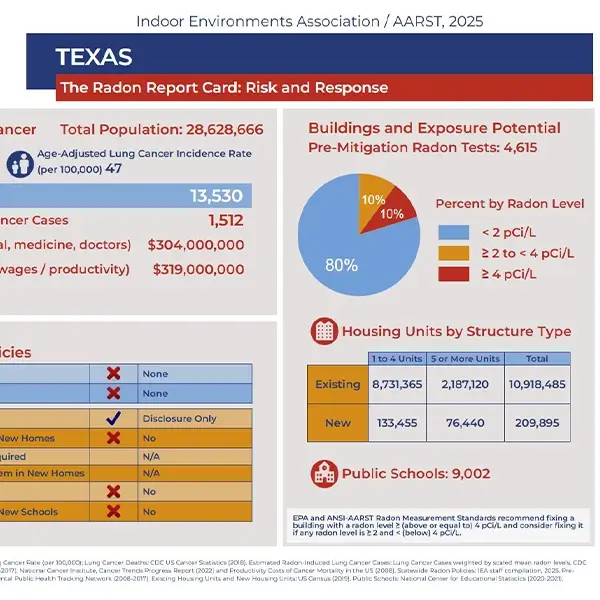Radon is a prevalent concern across the entirety of the U.S. for many home and business owners. Thankfully, there are numerous organizations that work to monitor radon levels across residential and commercial structures over long periods of time. While these do not negate the need for testing for individual buildings, these resources can provide incredibly helpful snapshots of larger radon trends for specific states and counties. One such resource is the Indoor Environments Association’s Radon Report Cards.
What is the Indoor Environments Association?
The Indoor Environments Association (IEA), formerly known as AARST, is a nonprofit organization committed to advancing indoor air quality through ethical, science-backed standards. Their focus includes radon mitigation, chemical vapor intrusion, and other indoor environmental hazards. As professional members of the IEA, Southwest Radon Eliminators follows the strict ethical and technical guidelines established in partnership with the National Radon Proficiency Program (NRPP).
One of the IEA’s most impactful public resources is its annual Radon Report Cards, which evaluate state-level radon policies and risk using objective, data-driven criteria. Designed for policymakers, radon professionals, advocates, and consumers alike, the report cards aim to identify gaps in awareness, testing, and regulation. They serve as a tool to help stakeholders push for improved radon safety in homes, schools, and other buildings nationwide.
What Are Radon Report Cards?
IEA’s Radon Report Cards compile national data to assess each state’s radon testing rates, mitigation efforts, average radon levels, and estimated lung cancer cases linked to radon exposure. These assessments also factor in radon-related policies, such as school testing requirements and real estate disclosure laws, to highlight which states are making progress and which have room to improve.
Data sources include the CDC, EPA, American Lung Association, U.S. Census Bureau, and other federal agencies, covering everything from housing statistics and public-school infrastructure to lung cancer mortality and estimated health care costs. By translating this complex information into accessible scorecards, the IEA helps communities better understand their radon risk and encourages action through clearer public health benchmarks.
Know the Risk – Test Your Property
While statewide data can help identify areas of concern, radon risk ultimately varies from building to building, even on the same street. That is why individual testing remains essential. If you live or work in a region flagged by the IEA’s Radon Report Cards or simply want peace of mind about the air quality in your space, professional testing is the best first step. Southwest Radon Eliminators offers precise, reliable radon testing for both residential and commercial properties to help you make informed decisions and take action when needed.
Radon is a widespread concern across the U.S., and while regional data can offer insights into broader trends, individual testing remains crucial due to property-specific risks. The Indoor Environments Association (IEA), formerly AARST, is a nonprofit dedicated to improving indoor air quality through ethical, science-based standards, including radon mitigation. One of their key resources is the annual Radon Report Cards, which use federal data to evaluate each state’s radon policies, testing rates, and health impacts, helping stakeholders identify areas needing improvement.
